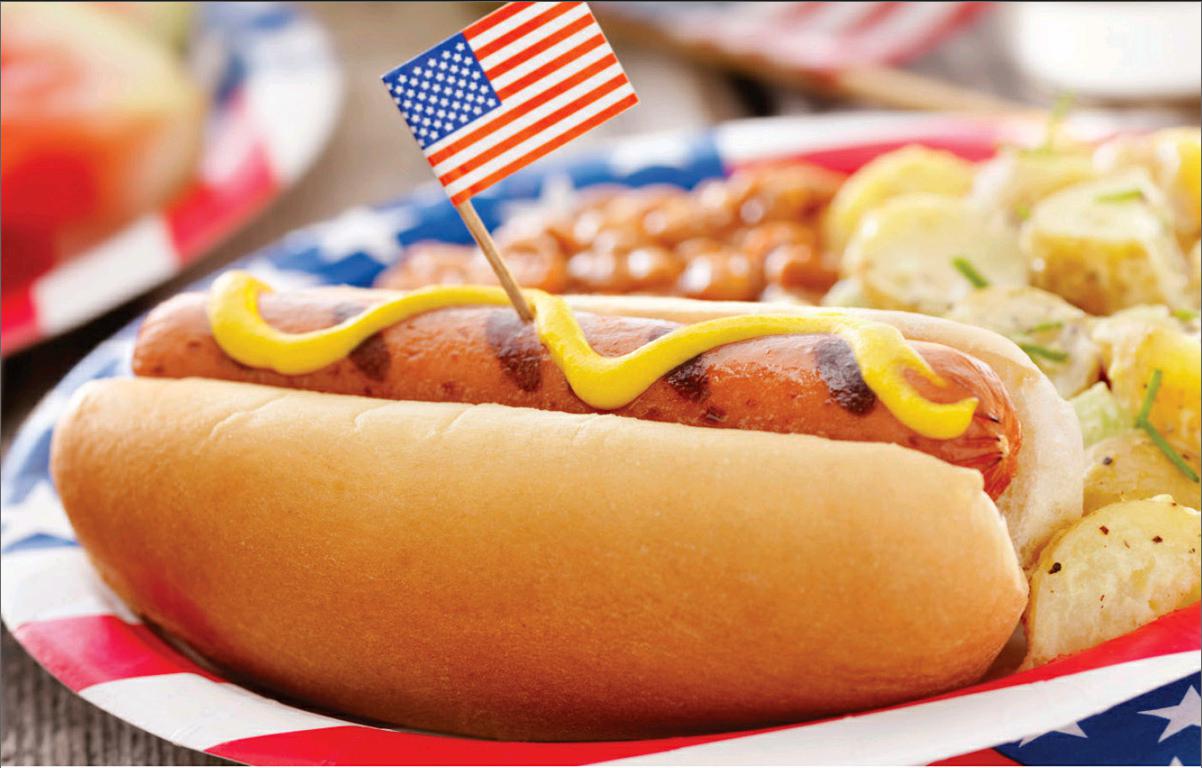自由之土,热狗之乡
By+Bruce+Kraig++赵青奇

提起热狗,人们首先想到的就是美国。这一“面包夹香肠”的简单组合在这片自由的土地上衍生出各种不同的形态,如此普通,如此廉价,却又如此具有魔力,吸引着各个阶层的人。从某种意义上说,咬一口手中的热狗,你便品尝到了一点自由和平等的味道。
Between Memorial Day1) and Labor Day2), about 7 billion hot dogs will be consumed in the United States. On the Fourth of July alone, 150 million will be gobbled3) by Americans celebrating the birth of the nation. Not that the Founding Fathers polished off4) batches of them after putting the final touches on the Declaration of Independence. Hot dogs as we know them today did not exist until nearly 100 years later. But they really are an American creation, and in a way the product of social and economic forces that the founders unleashed, wittingly5) or otherwise.
Why hot dogs? After all, they are just small sausages made of meat (and other things in the cheapest of them) sold for as low as a dollar or two a package. Most Americans think of them as common, cheap and somewhat suspect. Food connoisseurs6) Thomas Jefferson and Benjamin Franklin would have considered hot dogs to be the lowest of foods.
But if the nations founders were taken to a ballgame7) today where they could eat hot dogs (picture George Washington chomping8) down on a condiment9)-laden one with his “wooden” teeth10)), they would surely recognize the meaning inherent11) in them. Jefferson probably would be suspicious of a mass-produced commercial sausage since it was not made at home or in a small shop by an artisan. Alexander Hamilton12) (not a signer of the Declaration of Independence but a founder nonetheless) would have liked the industrial production and commerce as builders of the nations wealth. Franklin no doubt would have been fascinated by the science and technology used in the manufacturing process.
Hot dogs came to be part of American popular culture because of history and the sometimes mysterious workings of popular culture. But as much as anything, hot dogs just plain taste good. Dressed in various toppings or even relatively plain with mustard and maybe onions (but never ketchup), the combination of chewy meat, fat, salt and seasonings with a white bread bun is irresistible.
So they seemed to Americans when German immigrants brought their sausage culture (and beer) in the mid-19th century. Later, German, East European Jewish, Greek and Italian vendors sold them on the streets and in the new venues of affordable mass entertainment such as Coney Island13) and baseball parks. In the new Industrial Age, hot dogs seemed just right to Americans: cheap, meaty and served fast.
The founders also would have recognized some of their ideals for a new nation in the hot dog story: American individualism, can-do14) spirit and egalitarianism15). Although hot dogs are mass-produced, people have adapted them to their individual tastes and then into something that becomes iconic versions of their city or region.
As just a sampling, youll find a “garden on a bun in Chicago16),” deep-fried rippers17) and Italian hot dogs in New Jersey, cream cheese ones in Seattle and Sonoran hot dogs18) in Arizona and across the Southwest. The Sonoran dogs and Los Angeles “danger dogs” are bacon-wrapped and cooked on griddles19) with slight differences in toppings. They both come by way of Latino immigrants, just as the original versions were from German immigrants. All of these are variations created by small-scale hot dog hawkers20). Even the décor21) of many carts and stands operated by small entrepreneurs who hope to rise economically reflects this liberty to exist and operate in America.
As food, hot dogs are a symbol and means of social integration. Eating one with fellow enthusiasts from all walks of life is an act of community solidarity, especially at a ballpark with fellow fans. And it is part of the lovely myth of social equality that Americans hold dear. As one authority, Beverley Pink of Pinks Hot Dogs22) in Los Angeles, likes to say, customers from a cross-section of society—the minimum-wage worker and the celebrity in his fancy car—all stand in line to order their food and get the same dish.
Jefferson would have liked the idea of small communities of equals (his slaves excepted) standing in line—his White House dinners were like that. But Hamilton would never have descended from his Rolls-Royce. Who was more American and who would have loved hot dogs more?
从阵亡将士纪念日到劳动节这段时间,美国的热狗消费量将达70亿个。仅在7月4日这天,欢度国庆节的美国人就会吃掉1.5亿个热狗。这倒不是因为开国元勋们完成《独立宣言》最后的润色后对着一批热狗大快朵颐—我们今天所熟知的热狗是在近100年之后才出现的。不过,热狗确实是美国人的发明,从某种意义上说,它是开国元勋们解放的社会和经济力量有意无意催生的产物。
为什么偏偏是热狗呢?说到底,它们不过是肉做的小香肠(最便宜的热狗里,肉里会掺入其他东西)而已,售价低到一份只要一两美元。在大多数美国人眼里,热狗普通、廉价,吃着还有点不放心。若是在托马斯·杰斐逊和本杰明·富兰克林这样的美食行家看来,热狗估计是最低级的食品。
但是,假如将这些开国元勋带到如今的棒球比赛现场,让他们在那儿尝尝热狗(想象一下乔治·华盛顿用他的“木”牙大嚼一个洒满调料的热狗的情景),他们定会明白热狗所蕴含的固有内涵。杰斐逊可能会对这种批量生产的商业化香肠心怀疑虑,因为它既不是家庭自制,也不是出自小作坊的手艺人。亚历山大·汉密尔顿(不是《独立宣言》的签署人,但也算开国元勋)可能会赞赏与热狗相关的工业生产和商业活动,将其视为创造国家财富的力量。富兰克林则无疑会对热狗生产过程中运用到的科学技术感到着迷。
热狗成为美国流行文化的一部分,既有历史的原因,也离不开流行文化有时所具有的奇妙运作方式。但其中一个主要原因是,热狗吃起来就是很美味。加上各种各样的调料,或者哪怕只是相对简单地放点芥末,也许再加点洋葱(但千万别放番茄酱),这种耐嚼的肉、油脂、盐、佐料与白面包的混合体简直令人无法抗拒。
这就是19世纪中期美国人眼中的热狗,其时德国移民将他们的香肠文化(还有啤酒)带到美国。后来,德裔、东欧犹太裔、希腊裔和意大利裔的小贩们在街头以及不那么昂贵的大众娱乐新场所(如科尼岛和棒球场)卖起了热狗。在新的工业时代,热狗似乎恰好合乎美国人的需求:便宜,肉多,出餐快。
开国元勋们也可以从热狗的发展历史中发现他们寄予新国家的一些理想:美国的个人主义、进取精神和平等主义。尽管热狗是批量生产的,但人们依据个人口味对其进行了改造,从而衍生出他们所在城市或地区的特色热狗。
比如,你会发现有“芝加哥菜园式热狗”、新泽西的油炸裂皮热狗和意大利式热狗、西雅图的奶油干酪热狗以及亚利桑那州和美国西南部的索诺拉热狗。索诺拉热狗和洛杉矶的“危险热狗”外面都裹着培根,用平底锅煎炸而成,只是配料略有不同。两者均由拉丁裔移民引入,正如最早的热狗出自德国移民之手。所有这些种类不同的热狗都是小规模经营的热狗小贩们的发明。就连这些希望发家致富的小业主们的推车和摊铺的装饰也能反映出在美国谋生和经营的自由。
作为一种食物,热狗是社会融合的一种象征和方式。跟各行各业对热狗有同好的人一起吃热狗是体现群体团结的一种行为,尤其是在棒球场跟众多球迷一起吃热狗。这种行为也是美国人所珍视的社会平等这一美好幻想的一部分。正如洛杉矶平克热狗店的一位热狗权威人士贝弗利·平克常说的那样,社会各阶层的顾客—无论是拿最低薪酬的工人还是开着豪车的明星—都排队点餐,吃到的都是同样的食物。
杰斐逊可能会喜欢小群体内平等的人们(他的奴隶除外)排队候餐这个想法—他的白宫晚宴就是如此。但是汉密尔顿可决不会屈尊走下他的劳斯莱斯座驾。两人谁更有美国范儿,谁会更喜欢热狗呢?

